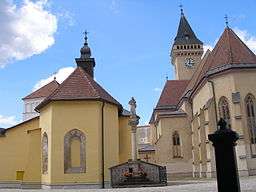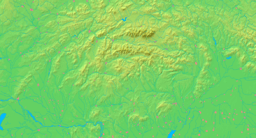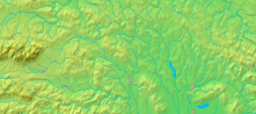Sabinov
| Sabinov | |
| Town | |
 Churches in Sabinov | |
| Country | Slovakia |
|---|---|
| Region | Prešov |
| District | Sabinov |
| River | Torysa |
| Elevation | 324 m (1,063 ft) |
| Coordinates | 49°06′22″N 21°05′08″E / 49.10611°N 21.08556°ECoordinates: 49°06′22″N 21°05′08″E / 49.10611°N 21.08556°E |
| Area | 23.392 km2 (9.032 sq mi) |
| Population | 12,378 (2005-12-31) |
| Density | 529/km2 (1,370/sq mi) |
| First mentioned | 1248 |
| Mayor | Peter Molčan |
| Timezone | CET (UTC+1) |
| - summer (DST) | CEST (UTC+2) |
| Postal code | 083 01 |
| Area code | +421-51 |
| Car plate | SB |
  Location of Sabinov in Slovakia | |
  Location of Sabinov in the Prešov Region | |
| Wikimedia Commons: Sabinov | |
| Statistics: MOŠ/MIS | |
| Website: www.sabinov.sk | |
Sabinov (Latin: Сibinium, Hungarian: Kisszeben, German: Zeben, Russian: Сабинов) is a small town located in the Prešov Region (north-eastern Slovakia), approximately 20 km from Prešov and 55 km from Košice. The population of Sabinov is 12,717.
Etymology
The name apparently comes from some shortened Slavic personal name, e.g. Soba, Sobin, Sobina (probably a short form of Soběslav).[1] In Poland, there are documented personal names Soba, Zoba, Sobien (Soben or Sobin), Sobon (Soboń) and medieval vilage names Szebne, Szobniow. In the Czech Republic, Sobyn, Sobień, Soběn and medieval vilage names Sobyenow, Sobíňov, Soběnov. The theory about the origin in a personal name is supported also by the common Slavic possessive suffix -ov preserved in later documents. The names Zob, Zoba, Zobas were used also in the Kingdom of Hungary in the 12th-13th century, but they may not be related to Soběslav and could be also of Hungarian origin.[2]
As legend has it, the name derives from the daughter of the landlord of Tharkveley called Szabina who would have been the wife of Andrew II of Hungary, and the king built the city in remembrance of her.[3]
1299 Scibinio, 1471 Sabinov, 1518 Kiss Zeben.[2]
History
The first written record about Sabinov is from the year 1248 (Sceben).[4] Sabinov was initially a Slovak village[5] until German settlers came in the middle of the 13th century.[5] In 1299 Sabinov received municipal privileges, and in 1405 it was declared a free royal town by king Sigismund, Holy Roman Emperor. In the 15th century Sabinov joined the Pentapolitana, an alliance of five towns of northeastern Kingdom of Hungary (Bardejov/Bártfa, Levoča/Lőcse, Košice/Kassa, Prešov/Eperjes and Sabinov/Kisszeben).[6] The 16th and 17th century was the era of Sabinov's development and economic growth followed by the years of recession. In 1740, an important secondary school was established by the Piarists. The history of Sabinov is very similar to the history of other towns in this region.
Demographics
According to the 1880 census, the town had 2,825 inhabitants, 2,088 Slovaks (73.9%), 245 Hungarians (8.7%), 412 Germans (14.6%) and others.[7]
According to the 1910 census, the town had 3,288 inhabitants, 1,640 Slovaks (49.9%), 1,168 Hungarians (35.5%), 341 Germans (10.4%), 120 Romanians (3.6%) and others.[8]
According to the 2001 census, the town had 12,290 inhabitants. 90.62% of inhabitants were Slovaks, 6.40% Roma, 0.48% Czechs and 0.14% Rusyns. Most of the Hungarians were expelled after World War II and their houses confiscated in the "slovakization" of Sabinov.[9] The religious makeup was 70.48% Roman Catholics, 10.53% Greek Catholics, 5.14% people with no religious affiliation and 4.16% Lutherans.[9]
The Shop on Main Street
The acclaimed Czechoslovak film, The Shop on Main Street, which was shot in Sabinov during 1964, was awarded the Academy Award for Best Foreign Language Film (of 1965) in Hollywood in 1966. In 1967 the film's lead actress, Ida Kaminska, was nominated for the Best Actress in a Leading Role for her screen work in this motion picture. She and the lead actor, Jozef Kroner, were also honored at the Cannes Film Festival in France for their roles in the film.
Famous people
The most important people who lived in Sabinov are:
- Pavol Peter Gojdič (17. 7. 1888 - 17. 7. 1960), Greek Catholic bishop. Since 1917 worked in Sabinov as an assistant parish priest. In 1951 sentenced by the communists to serve a life sentence and died in 1960 in prison of Leopoldov of ill-treatment. In 2001 was beatified by Pope John-Paul II.
- Bohuš Nosák-Nezabudov (3. 2. 1818 - 5. 4. 1877), poet, writer, journalist. Member of Ľudovít Štúr's group. Lived with his brother, who was a priest in Sabinov
- Anton Prídavok (28. 5. 1904 - 12. 5. 1945), poet, writer, playwright, director
- Tivadar Csontváry Kosztka (5 July 1853 - 20 June 1919), famous painter, who was born in Sabinov
- Ede Bartsch (1796 - 1871), famous Hungarian doctor
- Károly Wagner (1732 - 1790), Hungarian historian, priest, teacher
External links
References
- ↑ Hudáček, Pavol (2010). "Sabinov". In Štefánik, Martin; Lukačka, Ján. Lexikón stredovekých miest na Slovensku [Lexicon of Medieval Towns in Slovakia] (PDF) (in Slovak and English). Bratislava: Historický ústav SAV. p. 404. ISBN 978-80-89396-11-5.
- 1 2 Hudáček 2010, p. 404.
- ↑ András Vályi - Magyar országnak leírása, p. 324-325, 1799
- ↑ Štefánik & Lukačka 2010, p. 404.
- 1 2 Štefánik & Lukačka 2010, p. 410.
- ↑ Štefánik & Lukačka 2010, p. 409.
- ↑ Majo, Juraj (2012). Historicko-demografický lexikón obcí Slovenska 1880—1910. Bratislava: Štatistický úrad Slovenskej republiky. p. 122. ISBN 978-80-8121-222-2.
- ↑ Majo 2012, p. 830.
- 1 2 "Municipal Statistics". Statistical Office of the Slovak republic. Archived from the original on 2007-11-16. Retrieved 2007-12-15.